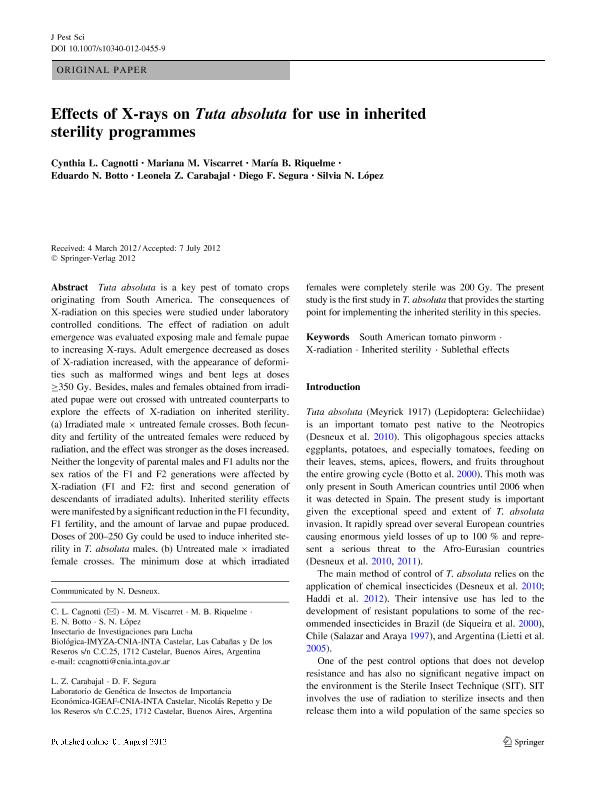Mostrar el registro sencillo del ítem
dc.contributor.author
Cagnotti, Cynthia Lorena

dc.contributor.author
Viscarret, Mariana Mabel

dc.contributor.author
Riquelme, Maria B.
dc.contributor.author
Botto, Eduardo Norberto

dc.contributor.author
Carabajal Paladino, Leonela Zusel

dc.contributor.author
Segura, Diego Fernando

dc.contributor.author
López, Silvia N.
dc.date.available
2023-05-11T11:06:08Z
dc.date.issued
2012-08
dc.identifier.citation
Cagnotti, Cynthia Lorena; Viscarret, Mariana Mabel; Riquelme, Maria B.; Botto, Eduardo Norberto; Carabajal Paladino, Leonela Zusel; et al.; Effects of X-rays on Tuta absoluta for use in inherited sterility programmes; Springer Heidelberg; Journal of Pest Science; 8-2012; 1-9
dc.identifier.issn
1612-4758
dc.identifier.uri
http://hdl.handle.net/11336/197111
dc.description.abstract
Tuta absoluta is a key pest of tomato crops originating from South America. The consequences of X-radiation on this species were studied under laboratory controlled conditions. The effect of radiation on adult emergence was evaluated exposing male and female pupae to increasing X-rays. Adult emergence decreased as doses of X-radiation increased, with the appearance of deformities such as malformed wings and bent legs at doses C350 Gy. Besides, males and females obtained from irradiated pupae were out crossed with untreated counterparts to explore the effects of X-radiation on inherited sterility. (a) Irradiated male 9 untreated female crosses. Both fecundity and fertility of the untreated females were reduced by radiation, and the effect was stronger as the doses increased. Neither the longevity of parental males and F1 adults nor the sex ratios of the F1 and F2 generations were affected by X-radiation (F1 and F2: first and second generation of descendants of irradiated adults). Inherited sterility effects weremanifested by a significant reduction in the F1 fecundity, F1 fertility, and the amount of larvae and pupae produced. Doses of 200?250 Gy could be used to induce inherited sterility in T. absoluta males. (b) Untreated male 9 irradiated female crosses. The minimum dose at which irradiated females were completely sterile was 200 Gy. The present study is the first study in T. absoluta that provides the starting point for implementing the inherited sterility in this species.
dc.format
application/pdf
dc.language.iso
eng
dc.publisher
Springer Heidelberg

dc.rights
info:eu-repo/semantics/openAccess
dc.rights.uri
https://creativecommons.org/licenses/by-nc-sa/2.5/ar/
dc.subject
South American tomato pinworm
dc.subject
X-radiation
dc.subject.classification
Zoología, Ornitología, Entomología, Etología

dc.subject.classification
Ciencias Biológicas

dc.subject.classification
CIENCIAS NATURALES Y EXACTAS

dc.title
Effects of X-rays on Tuta absoluta for use in inherited sterility programmes
dc.type
info:eu-repo/semantics/article
dc.type
info:ar-repo/semantics/artículo
dc.type
info:eu-repo/semantics/publishedVersion
dc.date.updated
2023-05-10T15:50:08Z
dc.journal.pagination
1-9
dc.journal.pais
Alemania

dc.description.fil
Fil: Cagnotti, Cynthia Lorena. Instituto Nacional de Tecnología Agropecuaria. Centro de Investigación en Ciencias Veterinarias y Agronómicas. Instituto de Microbiología y Zoología Agrícola; Argentina. Consejo Nacional de Investigaciones Científicas y Técnicas; Argentina
dc.description.fil
Fil: Viscarret, Mariana Mabel. Consejo Nacional de Investigaciones Científicas y Técnicas; Argentina. Instituto Nacional de Tecnología Agropecuaria. Centro de Investigación en Ciencias Veterinarias y Agronómicas. Instituto de Microbiología y Zoología Agrícola; Argentina
dc.description.fil
Fil: Riquelme, Maria B.. Instituto Nacional de Tecnología Agropecuaria. Centro de Investigación en Ciencias Veterinarias y Agronómicas. Instituto de Microbiología y Zoología Agrícola; Argentina
dc.description.fil
Fil: Botto, Eduardo Norberto. Instituto Nacional de Tecnología Agropecuaria. Centro de Investigación en Ciencias Veterinarias y Agronómicas. Instituto de Microbiología y Zoología Agrícola; Argentina
dc.description.fil
Fil: Carabajal Paladino, Leonela Zusel. Instituto Nacional de Tecnología Agropecuaria; Argentina. Consejo Nacional de Investigaciones Científicas y Técnicas; Argentina
dc.description.fil
Fil: Segura, Diego Fernando. Instituto Nacional de Tecnología Agropecuaria; Argentina. Consejo Nacional de Investigaciones Científicas y Técnicas; Argentina
dc.description.fil
Fil: López, Silvia N.. Instituto Nacional de Tecnología Agropecuaria. Centro de Investigación en Ciencias Veterinarias y Agronómicas. Instituto de Microbiología y Zoología Agrícola; Argentina
dc.journal.title
Journal of Pest Science

dc.relation.alternativeid
info:eu-repo/semantics/altIdentifier/url/https://link.springer.com/article/10.1007/s10340-012-0455-9
dc.relation.alternativeid
info:eu-repo/semantics/altIdentifier/doi/http://dx.doi.org/10.1007/s10340-012-0455-9
Archivos asociados
